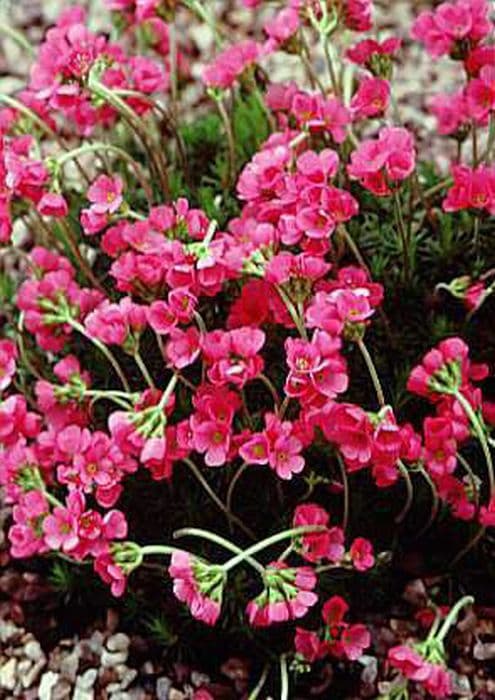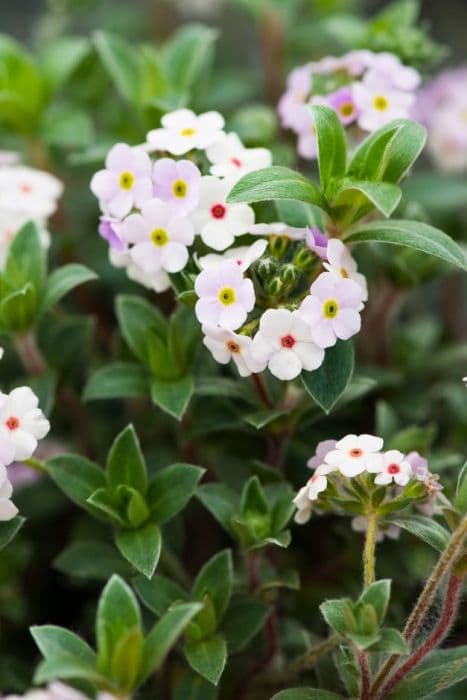Rock Jasmine Androsace studiosorum

ABOUT
The Androsace studiosorum, commonly known as rock jasmine, is a charming alpine plant notable for its rosette-forming habit. The leaves of rock jasmine are small, narrow, and lance-shaped, often covered with fine, soft hairs that give them a velvety texture. These leaves are predominantly green, sometimes with a hint of gray due to the fine hairs. The flowers of rock jasmine are its most distinguished feature. They bloom in clusters on top of short stems that rise slightly above the foliage. Each flower is delicate, with five petals that are usually pale pink to white in color. The center of the flower often has a contrasting yellow or red eye, which adds to its ornamental appeal. The overall growth form of rock jasmine is compact, with the rosettes and flowering stems creating a dense, cushion-like appearance. This plant thrives in rock gardens, crevices, and alpine troughs where it can mimic its natural mountainous habitat. Despite its delicate looks, rock jasmine is a hardy plant that can withstand harsh conditions typically found at high altitudes.
About this plant
 Names
NamesFamily
Primulaceae
Synonyms
Rock Jasmine, Engler's Androsace
Common names
Androsace studiosorum, Douglasia studiosorum.
 Toxicity
ToxicityTo humans
Androsace studiosorum, commonly known as rock jasmine, is not known to be toxic to humans. There is limited information on the toxicity of this specific species, and it is not typically listed as a concern for human poisoning. Therefore, no symptoms of poisoning are generally associated with the ingestion of rock jasmine. However, it is always advisable to avoid eating plants that are not specifically grown for consumption, as they may cause an unexpected allergic reaction or gastrointestinal discomfort due to individual sensitivities or the presence of natural compounds.
To pets
Rock jasmine is not commonly listed as a toxic plant to pets. There is no significant evidence to suggest that Androsace studiosorum poses a poisoning risk to pets such as cats and dogs. Consequently, there are no specific symptoms of poisoning associated with this plant when it comes to pets. However, as with humans, ingestion of non-food plants can sometimes lead to gastrointestinal upset or an allergic reaction in sensitive pets, so it is generally recommended to prevent pets from consuming plants not intended for them.
 Characteristics
CharacteristicsLife cycle
Perennials
Foliage type
Evergreen
Color of leaves
Green
Flower color
Pink
Height
0.5 inches [1.27 cm]
Spread
6 inches [15.24 cm]
Plant type
Herb
Hardiness zones
5
Native area
Europe
Benefits
 General Benefits
General Benefits- Aesthetic appeal: Alpine Rock Jasmine adds charm to gardens with its delicate, white or pink flowers and low-growing habit.
- Pollinator attraction: It attracts beneficial insects such as bees, which are essential for pollinating many other plant species.
- Alpine habitat support: Native to alpine regions, it plays a role in supporting these unique ecosystems' biodiversity.
- Erosion control: The plant’s mat-forming growth can help stabilize soil in garden rockeries or sloped areas.
- Easy to propagate: Alpine Rock Jasmine can be easily propagated from seed or division, making it a user-friendly plant for gardeners.
- Drought tolerance: Once established, it is relatively drought-tolerant, requiring minimal watering and making it suitable for rock gardens and xeriscaping.
- Seasonal interest: It blooms in late spring to early summer, providing seasonal color when other alpine plants may not be in flower.
- Low maintenance: Alpine Rock Jasmine is generally resistant to pests and diseases, reducing the need for chemical treatments.
- Cold hardiness: It’s capable of withstanding cold temperatures, making it suitable for high-altitude or northern gardens.
- Ground cover: Its ability to form dense mats makes it an excellent ground cover option, suppressing weeds and covering bare spots.
 Medical Properties
Medical PropertiesThis plant is not used for medical purposes.
 Air-purifying Qualities
Air-purifying QualitiesThis plant is not specifically known for air purifying qualities.
 Other Uses
Other Uses- Rock Garden Accent: Rock Jasmine is often used in rock gardens due to its ability to thrive in rocky substrates and enhance the garden's aesthetics with its delicate flowers.
- Alpine Plant Display: This plant is admired by alpine plant enthusiasts and used to create miniature alpine landscapes in trough gardens or cold frames.
- Education: Botany students and plant enthusiasts study the Rock Jasmine to understand its survival mechanisms in high-altitude habitats.
- Bee Attraction: The flowers of Rock Jasmine can attract bees and other pollinators, thereby supporting local ecosystems.
- Photography Subject: Due to its picturesque form, Rock Jasmine is a popular subject for photographers, especially those specializing in plant and macro photography.
- Botanical Illustration: It has been used as a subject for botanical illustration, showcasing its intricate bloom structure and foliage.
- Ground Cover: Though not common, Rock Jasmine can be used as a ground cover in small areas of the garden where other plants might struggle to survive.
- Container Gardening: Gardeners may use Rock Jasmine in containers on patios or balconies, where it adds a touch of the alpine world to urban settings.
- Companion Planting: Rock Jasmine can be planted alongside other alpine species to create complementary plantings in specialized garden scenes.
- Cultural Significance: In some cultures, Rock Jasmine might be used in traditional ceremonies or gifted as a symbol of resilience due to its ability to grow in harsh environments.
Interesting Facts
 Feng Shui
Feng ShuiThe plant Rock Jasmine is not used in Feng Shui practice.
 Zodiac Sign Compitability
Zodiac Sign CompitabilityThe plant Rock Jasmine is not used in astrology practice.
 Plant Symbolism
Plant Symbolism- Endurance: The Rock Jasmine (Androsace studiosorum) often grows in high altitude and rocky terrain, symbolizing the ability to endure challenging conditions and survive in harsh environments.
- Community: Rock Jasmine plants usually grow in clusters, representing the importance of community and support among individuals for thriving together.
- Persistence: The plant's tendency to grow and bloom despite the minimal soil and nutrients available in its natural habitat reflects a strong will and persistence to thrive.
- Fragility: Despite its hardiness, the Rock Jasmine’s delicate flowers can represent the fragility of beauty and life, reminding us to appreciate and care for the natural world around us.
- Adaptability: The Rock Jasmine's ability to adapt to extreme conditions can be seen as a metaphor for flexibility and adaptability in life's circumstances.
 Water
WaterRock jasmine requires consistent moisture, so water it when the top inch of soil feels dry, which often equates to once or twice a week. Depending on the environment's humidity and temperature, it may need more or less frequent watering. As a general rule, aim for about one ounce of water per square foot of soil each week during the growing season. Adjustments should be made for rainfall and changes in environmental conditions to prevent overwatering.
 Light
LightRock jasmine thrives in full to partial sunlight. The ideal spot for this alpine plant is a location where it can receive morning sunlight and some afternoon shade, especially in hotter climates. Protecting the plant from the intense midday sun will help to keep the delicate flowers from getting scorched.
 Temperature
TemperatureRock jasmine does best in cool to moderate temperatures and can survive in temperatures ranging from just above freezing to about 75 degrees Fahrenheit. The ideal temperature range for this plant is between 50 and 70 degrees Fahrenheit. Extreme heat or cold is detrimental to the plant, so it should be protected from frost and high summer temperatures.
 Pruning
PruningRock jasmine benefits from occasional pruning to remove dead or damaged foliage and to maintain its compact shape. Pruning is best done in the early spring before the new growth begins. Light pruning can also be carried out after flowering to encourage further blooms and prevent the plant from getting leggy.
 Cleaning
CleaningAs needed
 Soil
SoilRock jasmine thrives in well-draining, gritty soil with a mix of sand, fine gravel, and loam. Aim for a slightly acidic to neutral pH, around 5.5 to 7.0, for the best growth.
 Repotting
RepottingRock jasmine should be repotted every 2-3 years to refresh the soil and accommodate growth. Choose a well-draining mix during each repotting.
 Humidity & Misting
Humidity & MistingRock jasmine prefers moderate humidity levels; not too dry but avoiding excessive dampness. Consistency in humidity is more important than extreme levels.
 Suitable locations
Suitable locationsIndoor
Place in bright, indirect light with cool temperatures.
Outdoor
Grow in partial shade, protect from harsh sun.
Hardiness zone
4-8 USDA
 Life cycle
Life cycleAndrosace studiosorum, commonly known as Rock Jasmine, begins its life cycle when seeds germinate in cool, moist conditions, often in alpine or subalpine environments. Seedlings establish a root system and form a basal rosette of leaves during their initial growth phase. As the plant matures, it produces flower stalks with clusters of small white or pink flowers, typically blooming in the late spring to early summer. Following pollination, often by insects, the flowers develop into small capsules containing numerous tiny seeds. These seeds are dispersed by wind or water, or through attachment to animal fur, leading to the colonization of new areas. The plant may endure through the harsh alpine winters by dying back to the ground and re-emerging from its perennial rootstock when conditions improve in spring.
 Propogation
PropogationPropogation time
Spring to Summer
Propogation: Androsace studiosorum, commonly known as Rock Jasmine, is best propagated through seed sowing. This should ideally take place in late winter to early spring. To propagate Rock Jasmine, evenly distribute the tiny seeds on the surface of a well-drained seed starting mix, but do not cover them as they require light for germination. The pot should be placed in a bright location but out of direct sunlight. To maintain a consistent level of moisture, cover the pot with a plastic wrap or a glass pane. The seeds typically germinate at temperatures between 65 to 75 degrees Fahrenheit (18 to 24 degrees Celsius). Seedlings can be transplanted into individual pots once they are large enough to handle and grown on until they are ready to plant out in their final positions.









